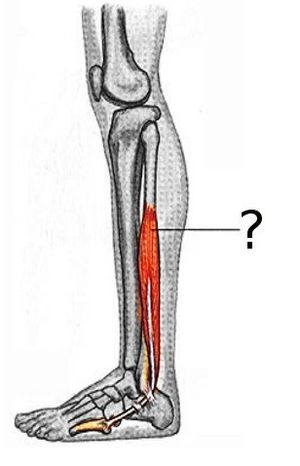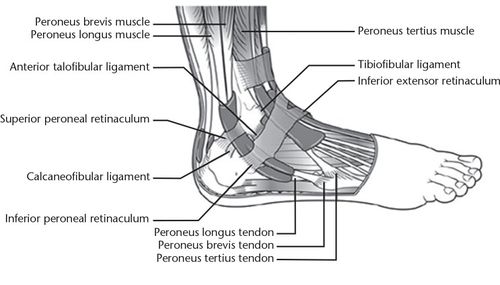Peroneus Brevis: Difference between revisions
Kim Jackson (talk | contribs) m (Text replacement - "[[Peroneal tendon subluxation" to "[[Peroneal Tendon Subluxation") |
Oyemi Sillo (talk | contribs) mNo edit summary |
||
| Line 2: | Line 2: | ||
== Description == | == Description == | ||
[[File:Peroneus brevis.jpg|thumb|The Peroneus brevis muscle origin and insertion. ]] | [[File:Peroneus brevis.jpg|thumb|The Peroneus brevis muscle origin and insertion. ]] | ||
Peroneus Brevis (also known as Fibularis Brevis) is a short [[muscle]] that lies in the lateral part of the lower leg deep to the [[Peroneus (Fibularis) Longus Muscle| | Peroneus Brevis (also known as Fibularis Brevis) is a short [[muscle]] that lies in the lateral part of the lower leg deep to the [[Peroneus (Fibularis) Longus Muscle|Fibularis Longus]].<ref name=":0">Basit H, Eovaldi BJ, Siccardi MA. [https://www.ncbi.nlm.nih.gov/books/NBK535427/ Anatomy, Bony Pelvis and Lower Limb, Foot Peroneus Brevis Muscle]. InStatPearls [Internet] 2019 May 19. StatPearls Publishing.</ref> | ||
It is one of the three ankle everters known as the | It is one of the three ankle everters known as the fibularis muscles (Fibularis Longus, Fibularis Brevis and [[Peroneus Tertius|Fibularis Tertius]]).<ref name=":1">Lippert, Lynn S. Clinical Kinesiology and Anatomy. 5th ed. Philadelphia: F A Davis Company; 2016. | ||
</ref> <ref name=":3">Palastanga N, Soames R. The Lower Limb. In: Anatomy and Human Movement: Structure and function. Edinburgh: Churchill Livingstone; 2012. p. 253–6.</ref> | </ref> <ref name=":3">Palastanga N, Soames R. The Lower Limb. In: Anatomy and Human Movement: Structure and function. Edinburgh: Churchill Livingstone; 2012. p. 253–6.</ref> | ||
The | The Fibularis Brevis along with the Fibularis Longus are commonly injured during a [[Ankle Sprain|lateral ankle sprain]] and the tendon of the Fibularis Brevis muscle is the most commonly dislocated tendon.<ref name=":0" /> | ||
=== Origin === | === Origin === | ||
The | The Fibularis Brevis originates from the distal two-thirds of lateral [[fibula]].<ref name=":0" /> Its tendon passes downwards and loops posterior to the lateral malleolus.<ref name=":1" /> | ||
=== Insertion === | === Insertion === | ||
The | The Fibularis Brevis inserts on the styloid process at the proximal end of the fifth metatarsal.<ref name=":0" /><ref name=":1" /> | ||
=== Nerve === | === Nerve === | ||
Superficial Peroneal nerve (L5-S2).<ref name=":0" /><ref name=":3" /> | Superficial Fibular (Peroneal) nerve (L5-S2).<ref name=":0" /><ref name=":3" /> | ||
=== Artery === | === Artery === | ||
Muscular branches of the peroneal artery.<ref name=":0" /> | Muscular branches of the fibular (peroneal) artery.<ref name=":0" /> | ||
== Function == | == Function == | ||
The | The Fibularis Brevis is responsible for 63% of the power needed to evert the foot as well as assists in plantar flexion along with the Fibularis Longus.<ref name=":1" /><ref name=":2">Davda K, Malhotra K, O’Donnell P, Singh D, Cullen N. [https://www.ncbi.nlm.nih.gov/pmc/articles/PMC5508858/ Peroneal tendon disorders]. EFORT open reviews. 2017 Jun;2(6):281-92.</ref> The fibularis muscles work together to provide dynamic lateral ankle stability during sudden ankle inversion stress.<ref name=":2" /> | ||
== Clinical relevance == | == Clinical relevance == | ||
| Line 28: | Line 28: | ||
Ankle and foot injuries are commonly seen in physiotherapy with a high prevalence of those injuries occurring at the lateral ankle. | Ankle and foot injuries are commonly seen in physiotherapy with a high prevalence of those injuries occurring at the lateral ankle. | ||
The most common injuries seen with the | The most common injuries seen with the Fibularis Brevis is to the tendon by way of [[Peroneal Tendinopathy|tendinopathy]], [[Peroneal Tendon Subluxation|dislocation/subluxation]], sprain or splitting.<ref name=":0" /> Tendon injuries to the Fibularis Brevis are usually caused by inversion or supination forces. With a lateral ankle sprain, it is possible that the Fibularis Brevis can tear and cause swelling at the lateral ankle.<ref name=":0" /> | ||
During a Supination-Adduction injury, the Peroneus Brevis tendon could be injured and could possible pull at the base of the 5th Metatarsal causing an avulsion fracture known as a [[Metatarsal Fractures|Jones Fracture]].<ref name=":0" /> | During a Supination-Adduction injury, the Peroneus Brevis tendon could be injured and could possible pull at the base of the 5th Metatarsal causing an avulsion fracture known as a [[Metatarsal Fractures|Jones Fracture]].<ref name=":0" /> | ||
== Assessment == | == Assessment == | ||
When assessing a patient for a | When assessing a patient for a Fibularis Brevis injury, an overall alignment of the leg and posture of the hindfoot must first be evaluated. Patients that present with hindfoot varus are predisposed to peroneal injury. Assessing the flexibility and correctability of the varus should be performed to determine the use of orthotic management.<ref name=":2" /> | ||
'''Observation:''' Upon observation, peroneal disorders will often present with swelling just posterior to the fibula or along the lateral wall of the calcaneus. Patients typically present with posterolateral ankle pain that worsens with activity and improves with rest. | '''Observation:''' Upon observation, peroneal disorders will often present with swelling just posterior to the fibula or along the lateral wall of the calcaneus. Patients typically present with posterolateral ankle pain that worsens with activity and improves with rest. | ||
Latest revision as of 17:20, 21 April 2023
Original Editor - Lilian Ashraf Top Contributors - Lilian Ashraf, Beverly Klinger, Kim Jackson, Abbey Wright and Oyemi Sillo
Description[edit | edit source]
Peroneus Brevis (also known as Fibularis Brevis) is a short muscle that lies in the lateral part of the lower leg deep to the Fibularis Longus.[1]
It is one of the three ankle everters known as the fibularis muscles (Fibularis Longus, Fibularis Brevis and Fibularis Tertius).[2] [3]
The Fibularis Brevis along with the Fibularis Longus are commonly injured during a lateral ankle sprain and the tendon of the Fibularis Brevis muscle is the most commonly dislocated tendon.[1]
Origin[edit | edit source]
The Fibularis Brevis originates from the distal two-thirds of lateral fibula.[1] Its tendon passes downwards and loops posterior to the lateral malleolus.[2]
Insertion[edit | edit source]
The Fibularis Brevis inserts on the styloid process at the proximal end of the fifth metatarsal.[1][2]
Nerve[edit | edit source]
Superficial Fibular (Peroneal) nerve (L5-S2).[1][3]
Artery[edit | edit source]
Muscular branches of the fibular (peroneal) artery.[1]
Function[edit | edit source]
The Fibularis Brevis is responsible for 63% of the power needed to evert the foot as well as assists in plantar flexion along with the Fibularis Longus.[2][4] The fibularis muscles work together to provide dynamic lateral ankle stability during sudden ankle inversion stress.[4]
Clinical relevance[edit | edit source]
Ankle and foot injuries are commonly seen in physiotherapy with a high prevalence of those injuries occurring at the lateral ankle.
The most common injuries seen with the Fibularis Brevis is to the tendon by way of tendinopathy, dislocation/subluxation, sprain or splitting.[1] Tendon injuries to the Fibularis Brevis are usually caused by inversion or supination forces. With a lateral ankle sprain, it is possible that the Fibularis Brevis can tear and cause swelling at the lateral ankle.[1]
During a Supination-Adduction injury, the Peroneus Brevis tendon could be injured and could possible pull at the base of the 5th Metatarsal causing an avulsion fracture known as a Jones Fracture.[1]
Assessment[edit | edit source]
When assessing a patient for a Fibularis Brevis injury, an overall alignment of the leg and posture of the hindfoot must first be evaluated. Patients that present with hindfoot varus are predisposed to peroneal injury. Assessing the flexibility and correctability of the varus should be performed to determine the use of orthotic management.[4]
Observation: Upon observation, peroneal disorders will often present with swelling just posterior to the fibula or along the lateral wall of the calcaneus. Patients typically present with posterolateral ankle pain that worsens with activity and improves with rest.
Palpation: may present with tenderness along the course of the tendons.
Range of motion testing may show pain with resisted eversion, passive inversion stretch, or resisted plantar flexion of the first ray. Active circumduction of the ankle may re-create tendon subluxation.
Strength testing is likely to elicit pain and will be reduced going into eversion.
Special tests such as the peroneal compression test should be performed to assess pain, crepitus, and “popping” at the posterior edge of the distal fibula during forceful ankle eversion and dorsiflexion.[4]
Treatment[edit | edit source]
Conservative Treatment[4][edit | edit source]
- Non-steroidal anti-inflammatory medication
- Rest
- Activity modification
- Orthoses with lateral forefoot posting in mild cases
- For persistent cases, immobilization in a short-leg cast or controlled ankle movement walker for six weeks may be helpful.
Surgical Treatment[4][edit | edit source]
Open Synovectomy: The tendon sheath is opened longitudinally and any damaged area of tendon is debrided.
Post-operatively, the foot and ankle are placed in a short-leg cast. Weight-bearing in the cast may begin after two weeks. Range of movement and strengthening are started after casting is discontinued at four to six weeks.
References[edit | edit source]
- ↑ 1.0 1.1 1.2 1.3 1.4 1.5 1.6 1.7 1.8 Basit H, Eovaldi BJ, Siccardi MA. Anatomy, Bony Pelvis and Lower Limb, Foot Peroneus Brevis Muscle. InStatPearls [Internet] 2019 May 19. StatPearls Publishing.
- ↑ 2.0 2.1 2.2 2.3 Lippert, Lynn S. Clinical Kinesiology and Anatomy. 5th ed. Philadelphia: F A Davis Company; 2016.
- ↑ 3.0 3.1 Palastanga N, Soames R. The Lower Limb. In: Anatomy and Human Movement: Structure and function. Edinburgh: Churchill Livingstone; 2012. p. 253–6.
- ↑ 4.0 4.1 4.2 4.3 4.4 4.5 Davda K, Malhotra K, O’Donnell P, Singh D, Cullen N. Peroneal tendon disorders. EFORT open reviews. 2017 Jun;2(6):281-92.
- ↑ Endurance Physio. Ankle Eversion (fibularis longus/brevis) Exercise. Available from:https://www.youtube.com/watch?v=JHyEHEwgc6A&feature=youtu.be [last accessed 13/02/2020]








